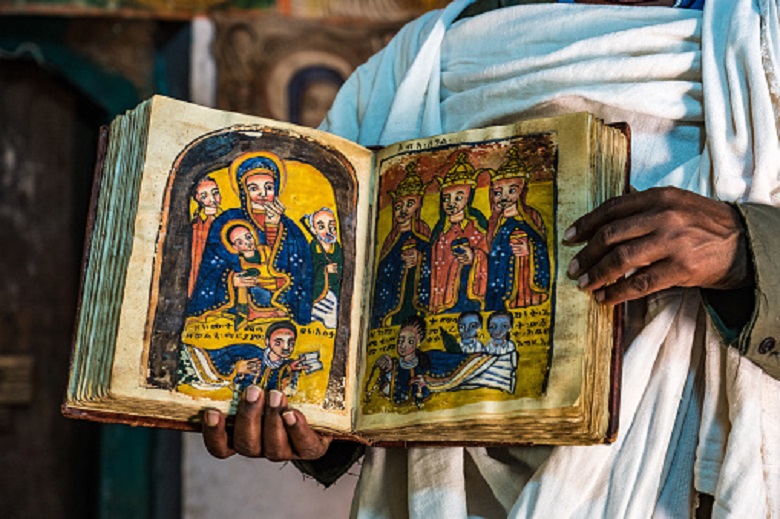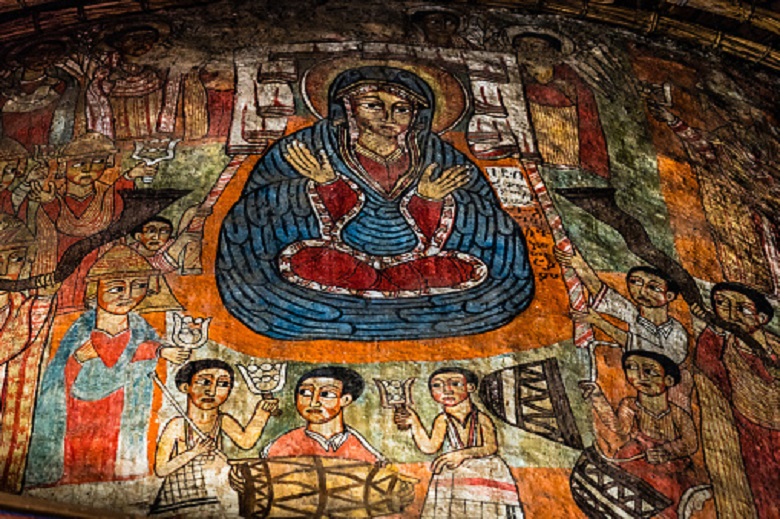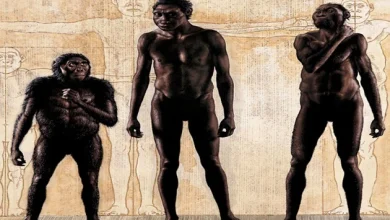Ethiopia, an African nation that has defended its independence

Although Ethiopia has been an arena of encounters and mingling of several multilingual peoples, the country’s culture over the centuries has a remarkable coherence and originality. The main reason for this is probably the geographical conditions. The high plains of Ethiopia, with their green uplands rising to 2000 meters above sea level, its mild climate, and peaceful scenery, are more reminiscent of the mountain ranges of Europe than of Africa.
The natural conditions, which to a certain extent isolated Ethiopia from the surrounding African countries with a Negro population on almost all sides, contributed to the creation here – many centuries ago – of civilization similar to the ancient civilizations of Egypt, Syria, and Arabia.
First of all, we must discard the hitherto widespread myth that ancient Ethiopia was closely related to the country of the Pharaohs. This Romanistic hypothesis was advanced two thousand years ago by many ancient authors. However, the country described in the works of Herodotus and the Aephopica of Heliodorus was not Ethiopia proper, but only the Sudanese state of Meroe. Nevertheless, there is evidence that a prehistoric Ethiopian civilization existed several millennia before Christ, although it did not leave behind any monuments.
Ancient Ethiopia was known to the Egyptians as “the land of Punt” or “land of the gods” – names applied to areas known for their incense; these areas were located on the Red Sea’s southern shores in East Africa and Arabia.
Legends dating back to the most ancient period of Egyptian history tell that some Egyptian gods and myths originated from these countries, from these shores, from where Egyptian merchants brought rare goods. However, the expeditions sent by the pharaohs never reached the high plateau. Some of them climbed up the Nile to the markets of Sudan. Others kept their way by sea, going to all coast points, where they could hope to buy wood, ivory, and rare animals.
While the world knew of the wealth and culture of the Minoan, Sabean, and other states of southern Arabia as early as a thousand years before Christ, the Abyssinian plateau was not reached by the first travelers from the shores of the Mediterranean until eight or ten centuries later; here they found great cities and powerful rulers.
Their descriptions are confirmed by ancient monuments that have survived to this day. At that time, Ethiopia undoubtedly had an already developed civilization with its own well-established laws and customs. The gates of the country were the large port of Adulis, where merchant ships came from both Ptolemaic Egypt and the Indian Ocean. The main cities were Koloe, the center of the ivory trade, located above Adulis, on the plateau’s edge, and Aksum, in the country’s interior.
The inhabitants of these cities were descendants of peoples who had long lived on both shores of the Red Sea. The most developed of them spoke the Semitic language and used the Sabean script. They abandoned the African religion and professed a faith akin to the religion of the great kingdoms of South Arabia. Their temples, altars, and other ancient monuments were built under the influence of remarkable buildings, the countless remains of which can be seen to this day on the plateaus of Yemen and Hadhramaut.
But this was not a simple imitation. Everything that was transferred to African soil underwent a complete transformation. The Ge’ez alphabet soon developed from the Sabaean script, which has survived in Ethiopia to our time. Sabean architecture received a new interpretation from peoples accustomed to carving huge blocks out of solid stone and erecting monolithic obelisks – as high as the giant structures of the pharaohs of Egypt.

They were undoubtedly a powerful people, for the rulers of Aksum extended their power even to Arabia, from where the first seeds of their culture were brought.
In the 3rd and 4th centuries, Ethiopia took over the trade on the southern shores of the Red Sea – a trade that had contributed to the exaltation of only the southern Arabian states engaged in the production of incense and spices. The international significance of Axum is also evidenced by the fact that the inscriptions on the coins of this state were made in Greek for some, albeit short, time – from the end of the 3rd century. Aksumite coins contained the same weight ratio of metals as Roman gold coins of the time, but the images on them were local; such coins were kept in circulation until the 9th century.
The greatest merit in the development of the ancient Ethiopian civilization belongs to King Ezana (about 320-350 AD). Under him, a letter reform was carried out: the Sabean alphabet, which had letters only for conveying consonants, was replaced by the Ge’ez alphabet, which also has signs for vowels. At the same time, approximately around 340 AD. e., Christianity penetrated the country, which has remained since then the national religion of Ethiopia. Christianity very soon acquired special characteristics here. Christian churches appeared, resembling Aksumite temples in architecture and combining decorative techniques borrowed from Arabia, Syria, Persia, and Coptic Egypt. Many monasteries were founded, and libraries were created with them, the initial fund of which consisted of collections of translations.
From the beginning of the 7th century, the decline experienced by the South Arabian states affected the Aksumite Empire as well. Trade in the Red Sea, on which all its prosperity was based, dwindled, and soon impoverished Ethiopia was cut off, apart from some threads that connected it to Egypt, from the rest of the world.
This situation remained unchanged until the 16th century. However, this, apparently, did not affect the culture of the country at all. On the contrary, during the reign of the Zague dynasty (10th century – 1270 AD), a new capital, the fantastic city of King Lalibela, arose in the mountainous province of Lasta. Its twelve temples mark both the end of the old artistic tradition and, without a doubt, its highest flowering.
Then comes the period of the Middle Ages, marked by the rapid prosperity of the regions lying south of the provinces of Tigre and Lasta. These areas encompassed the rugged Amhara mountains and the fertile Shoah plains. The letter Ge’ez was here adapted to one of the local dialects, and in the new alphabet, one could see only subtle traces of the old Sabean base. This dialect developed into Amharic, which is still the main language of the Ethiopian people. But Geez was not forgotten; it still continued to be applied in Christian liturgy and literature.
In this new era, many rulers have contributed to the prosperity of the nation. Among them were outstanding politicians, heroic military leaders, strict lawyers, theologians, and sometimes even inspired poets. One of the greatest kings was Zara Jacob (1434-1468). The reign of these kings was the time of creating monumental monuments, the time of the development of painting, the creation of extensive literature, and accurate, detailed chronicles.
External influences can be traced both in literature and in the art of this time; This is mainly the influence of Coptic Egypt and Syria, although occasionally one can observe a small admixture of the introduced features of European culture by unknown means.
Unfortunately, the Middle Ages in Ethiopia was marked by violent religious strife. The Muslims, with whom the old rulers of Aksum had the most cordial relations, were firmly rooted in the lowlands to the east of the high plateau, where several independent kingdoms were founded.
This branch of Islam, deeply Ethiopian in spirit and literature (although its language was Arabic), was initially peaceful. But soon, the Muslims launched an offensive against the Christian population of the mountainous regions. It was essentially an economic war; only for short periods did it take on a religious character.
The most violent attack of these tribes took place shortly before the middle of the 16th century; the troops, united under the leadership of Ahmed ibn Ibrahim, nicknamed the Edge, completely devastated large shopping centers, cities, and temples of Shoah, Amhara, and Tigre.
The ruler of Ethiopia turned to Portugal for help. In 1541, the Portuguese sent a small detachment of soldiers under the command of Christopher da Gama; through joint efforts, the Ethiopian and Portuguese Christians managed to save this kingdom with a thousand and a half years of history from the final defeat.
Newcomers from the West, although few in number, brought new technology to the country, but their arrival did not in the least affect the traditional culture of Ethiopia. Western influence quickly faded away since, after the Portuguese soldiers (who very soon disappeared into the mass of the Ethiopian population), only a few Catholic missionaries visited the country, whose teachings were resolutely rejected by the Ethiopian people.
Ethiopia has remained faithful to its rich ancient culture, although at the end of this period, new elements in painting and miniature and the emergence of a distinctive pictorial architecture can be observed, especially vividly represented in the imperial palaces of Gondar. The Western influence traced in these works is more or less indirect and, in all likelihood, does not come directly from European masters, but from builders and painters who came from India, where the Portuguese had recently contributed to the widespread dissemination of their techniques and artistic forms.
Ethiopia was destined to undergo another test before the beginning of the modern era – an unexpected invasion, wave after wave, of the Gaulish tribes who came from the south and southeast. However, over the centuries, these tribes disappeared among the indigenous population; some of the invaders adopted Christianity, some – Islam. Ethiopian culture emerged victorious from the struggle of this turbulent period, while the newcomers, on the contrary, adopted the classical severity of Ethiopian clothing and certain features of the legislation and social organization of this ancient empire.

The beginning of Ethiopia’s broad ties with Europe dates back to the opening of the Suez Canal. Since that time, some Ethiopian rulers have invited European experts to bring technical knowledge to the country that meets the simple way of life of its people. Contact between Ethiopia and European culture was facilitated by the fact that the Ethiopian people throughout their history had a written language, legislation, and their code of aesthetic ideas.
Ethiopia developed in conditions that were extremely favorable for the creation of a single culture, in that part of Africa, where the influences of all great civilizations, from the so-called classical to the distant eastern, could merge.




